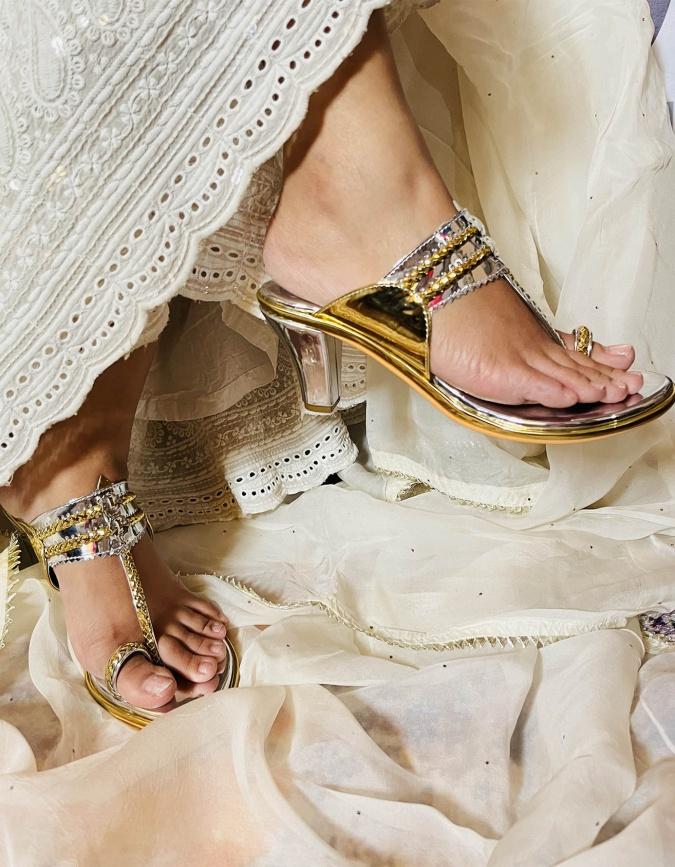Why Kolhapuri Heels Are a Must-Have in Every Woman’s Wardrobe

There’s something timeless about Indian footwear styles, and among them, Kolhapuri heels stand out for their charm, comfort, and versatility. Originally rooted in Maharashtra’s Kolhapur region, these handcrafted sandals have evolved from traditional leather flats to modern, elevated designs like multicolor block heels. Today, Kolhapuri heels are no longer just ethnic wear—they’ve become everyday staples for women who appreciate both cultural connection and practical style.
The Beauty of Tradition with a Modern Twist
Kolhapuri heels are known for their handcrafted details, leather craftsmanship, and unique open-toe structure. What makes them especially appealing today is the way they blend heritage with contemporary design. Brands like Idhaga have taken the classic Kolhapuri silhouette and elevated it—literally—by adding block heels, soft padding, and vibrant colors that go beyond the traditional browns and tans.
The result? A sandal that works equally well with jeans, summer dresses, sarees, or kurtas. You’re not just wearing a shoe—you’re carrying a piece of tradition into the modern world.
Why Kolhapuri Heels Work for Every Occasion
One of the reasons Kolhapuri heels have gained popularity is their adaptability. Whether you're heading to a casual brunch or attending a festive event, these sandals can easily complement your look.
-
Daily wear: Pair them with cotton kurtis or denims for an easygoing, comfortable style.
-
Work outfits: Multicolor or neutral-toned Kolhapuri block heels add elegance without compromising on comfort.
-
Festive or wedding events: Embroidered or embellished versions offer a beautiful alternative to heavy heels.
-
Travel-ready: With block heels and secure straps, they’re easier on the feet than stilettos and work great for longer walks or sightseeing.
And because they’re made with real leather or leather-alternatives, they tend to mold to your foot over time—giving you a more personalized fit the more you wear them.
The Rise of Multicolor Block Heels
Among the various modern styles, multicolor block heels are a standout. These heels add a pop of color and make it easy to match with multiple outfits. Instead of sticking to one shade, multicolor designs blend earthy and bright tones, creating an artisanal feel that’s playful yet refined.
This style appeals to those who want the cultural look of a Kolhapuri with a bit of flair. They're not overly flashy, but they do offer something different from typical Western heels or plain flats.
A Comfortable Alternative to Everyday Flats
While many women turn to footwear for women flats for daily wear, Kolhapuri heels offer a middle ground. You get the added support of a heel without the discomfort of pointed shoes or hard soles. Unlike some flats that can feel too thin or lack structure, Kolhapuri heels—especially those with block soles—give you both style and posture support.
They’re also more breathable than closed shoes, which is great for warm weather. The open design allows for airflow and reduces the chances of blisters or sweating.
Styling Tips for Kolhapuri Heels
If you’re new to Kolhapuri heels, here are a few simple ways to integrate them into your wardrobe:
-
With denim: Match your Kolhapuri heels with cropped jeans and a tucked-in blouse for a casual chic look.
-
With ethnic wear: Go for embroidered or beaded styles with kurtas, sarees, or suits.
-
With dresses: Pair a floral maxi dress with multicolor block heels for a breezy summer outfit.
-
With Indo-Western styles: Think of long skirts, palazzos, or even jumpsuits that carry an ethnic vibe.
Kolhapuri Heels vs. Jutti Shoes
A common question is: What’s the difference between Kolhapuri heels and jutti shoes?
Juttis are typically flat, closed-toe shoes made with fabric or leather and often feature embroidery or embellishments. They’re more structured and are often used for traditional occasions. On the other hand, Kolhapuris—especially the heeled versions—are open-toe, with a more laid-back, breathable design. They tend to be easier to walk in for long periods, especially when designed with cushioned soles and block heels.
While both have their place in a well-rounded wardrobe, Kolhapuri heels offer a more versatile option that bridges traditional and modern fashion.
Final Thoughts
Kolhapuri heels are more than just a trend—they’re a lasting piece of Indian footwear culture that has adapted beautifully to today’s fashion needs. Whether you’re someone who loves ethnic wear or simply looking for stylish, breathable sandals with a bit of history, Kolhapuri heels by Idhaga are worth adding to your wardrobe. They offer the ideal balance between tradition, comfort, and everyday versatility—making them a must-have for every woman.
Frequently Asked Questions (FAQs)
Q1: Are Kolhapuri heels comfortable for long wear?
Yes, especially block heel designs. Many Kolhapuri heels, like those from Idhaga, include cushioned soles and supportive straps, making them suitable for all-day wear.
Q2: Can Kolhapuri heels be worn with Western outfits?
Absolutely. Kolhapuri heels pair well with jeans, skirts, and dresses. Their handcrafted look adds an interesting touch to even the simplest outfits.
Q3: How are Kolhapuri heels different from regular flats?
Unlike most footwear for women flats, Kolhapuri heels offer added height and a structured feel, along with open designs that improve comfort in warm weather.
Q4: Do Kolhapuri heels come in different colors?
Yes. Traditional styles were mostly brown or tan, but modern collections now include multicolor and pastel shades to suit various tastes and outfits.
- Art
- Causes
- Best Offers
- Crafts
- Dance
- Drinks
- Film
- Fitness
- Food
- Jogos
- Gardening
- Health
- Início
- Literature
- Music
- Networking
- Outro
- Party
- Religion
- Shopping
- Sports
- Theater
- Wellness



